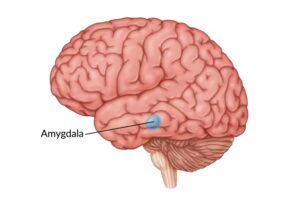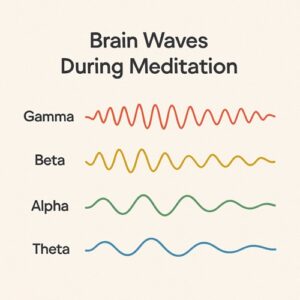
The scientific community’s interest in meditation has grown remarkably. Research expanded from a single study in the mid-1990s to 216 studies between 2013-2015. Scientists have made amazing discoveries about our brain’s structure through this expanded research.
Brain imaging studies prove meditation can slow down age-related brain decline and improve cognitive abilities. Research shows that people who meditate regularly have thicker cortical regions in areas of their brain linked to attention and memory. Vipassana meditation practitioners’ brains show notable differences in connectivity patterns, especially their right hippocampus, when compared to those who don’t meditate.
This piece will help you find the newest scientific evidence about meditation’s effects on your brain. You’ll learn about its role in lowering stress-related cortisol and improving memory during stressful times. The science behind these brain changes and practical ways to use meditation’s brain-enhancing benefits will become clear to you.
Research shows meditation changes the brain circuits that handle emotions and stress response. Your brain undergoes specific changes in important regions when you meditate regularly. These changes affect how you process emotions and deal with stress.

The amygdala is your brain’s emotional processing center and plays a vital role in stress response. This small almond-shaped structure becomes very active during threatening or emotional situations. Mindfulness practice can adjust how it works.
Studies with functional MRI and EEG recordings show meditation changes amygdala activity substantially [1]. Scientists have found decreased amygdala size and reactivity in people who practice mindfulness [1]. A breakthrough study showed people who finished an 8-week Mindfulness-Based Stress Reduction (MBSR) program had less amygdala activity when looking at emotional images [2].
The changes last beyond meditation sessions. Harvard scientists found lasting changes in how the amygdala worked during everyday tasks after people meditated for just two months [3]. This shows meditation creates lasting brain changes rather than just temporary effects.
The brain scans also show meditation reduces right amygdala activity when people see positive emotional images. With more practice, this happens with negative images too [4]. Scientists say “Meditation training may improve affective responding through reduced amygdala reactivity” [4].
These brain changes associate with several benefits:

The prefrontal cortex (PFC) becomes more active while the amygdala calms down during meditation. The PFC controls higher brain functions like emotional control, attention, and decision-making.
New brain imaging studies show meditation increases blood flow in the PFC [5]. The connection between the amygdala and ventromedial prefrontal cortex (VMPFC) gets stronger after mindfulness training [4].
This stronger amygdala-PFC connection helps improve emotional control. Research notes that “PFC’s functional connectivity decreases anxiety, depression, perceived stress, negative emotion, and hyperarousal symptoms” [6]. The PFC acts like a brake on the amygdala and helps create balanced emotional responses.
Different types of meditation can change specific parts of the PFC. The dorsolateral PFC becomes more active and boosts working memory and cognitive control. The dorsomedial PFC connects better with the amygdala during mindful breathing [6].
These brain changes create what scientists call “greater activation in brain regions associated with attention and emotion regulation” [7]. This helps you control emotional responses better. You can stay focused during stress and avoid getting stuck in negative thoughts.
The brain’s rewiring explains why people who meditate handle emotions better. It also shows why mindfulness helps with stress-related conditions. The evidence proves meditation does more than just calm your mind—it adjusts your brain’s emotional system for lasting benefits.
New research in neuroscience shows that meditation does more than calm your mind. It physically changes your brain through neuroplasticity – your brain’s ability to create new neural connections throughout life. These changes boost memory performance and make your cognitive functions more resilient.

The hippocampus is vital for memory formation and responds remarkably well to meditation. Intracranial electroencephalogram (EEG) recordings show measurable changes in hippocampal activity [8]. Your hippocampus plays a key role in emotional regulation and memory processes.
A breakthrough study found that people who completed a mindfulness program showed thickening in the hippocampus, which links to better memory consolidation [9]. Scientists at Mount Sinai made an even more interesting discovery – meditation changes deep brain areas that control memory function. This could explain why meditation boosts memory [8].
Meditation improves your prospective memory – knowing how to remember future actions. A study with 81 participants showed that focused attention and open monitoring meditation boosted prospective memory by improving cue monitoring [10]. This helps you remember tasks scheduled for specific times and situations that trigger certain actions.
Meditation also reshapes brain networks. Research showed statistically significant (p corrected = 0.009) higher connectivity in the right hippocampus among people who meditate compared to those who don’t [11]. This stronger connectivity means meditation makes your hippocampus more active in neural networks, which helps both prospective and spatial memories.
Your working memory – the brain’s temporary notepad – gets better with meditation. A single session of focused attention meditation (FAM) improves working memory capacity by activating both sides of the dorsolateral prefrontal cortex (DLPFC) [12]. Scientists found a link between DLPFC activation during meditation and better working memory capacity.
Meditation protects your brain during stressful times. Military personnel who meditated regularly showed better working memory under stress than those who rarely meditated [13]. This protection gives you a big advantage since stress usually hurts cognitive function.
The results are measurable. After meditation training, people remembered three more words on average than before [12]. Another study revealed impressive memory improvements:
The science behind this involves top-down attention control during meditation. You strengthen your ability to filter out distractions by practicing focused attention and returning to your focus point when your mind wanders [12]. This skill helps you remember things better in everyday life.
These improvements last long after your meditation session ends. This shows that meditation creates lasting changes in how your brain works, not just temporary effects. Better working memory helps you learn, plan, reason, and solve problems more effectively in your daily life.
Scientists use advanced brain imaging techniques to measure how meditation affects the brain. These methods have transformed our understanding of how mindful practices change neural structure and function.
 es
esFunctional magnetic resonance imaging (fMRI) is a key tool to learn about meditation’s effects on the brain. Unlike standard MRI, fMRI detects brain activity by recording blood oxygen level-dependent (BOLD) signals during meditation tasks [15]. This method lets researchers see which brain regions light up during different meditation states and how these patterns shift over time.
A breakthrough study showed that brain changes from meditation last even when people aren’t meditating. The research team scanned participants before and after an eight-week meditation course while they did everyday tasks—not meditation—and still found major changes in amygdala activation patterns [15].
Common fMRI protocols in meditation research are:
EEG works alongside fMRI and provides extra insights by measuring electrical activity through scalp electrodes [16]. EEG excels at catching quick changes in neural oscillations across different frequency bands—theta (4-8 Hz), alpha (8-13 Hz), and gamma (>25 Hz). Each band shows unique patterns during meditation [16].
Researchers often use Independent component analysis (ICA) techniques to pull meaningful data from complex brain signals [17]. One study noted that group independent component analysis (gICA) works well to study “training-related changes in functional connectivity among intrinsic connectivity networks during mindful rest” [17].
Most meditation brain imaging studies use standard MBSR protocols to keep methods consistent. Jon Kabat-Zinn developed MBSR in the 1970s at the University of Massachusetts Medical Center. It’s now considered “something of a clinical and scientific standard” [15].
The typical MBSR research protocol has:
Brain imaging studies usually follow a before-and-after design. Participants get brain scans before starting MBSR training and again after the eight-week program to see structural and functional changes [15].
Many studies also use active control groups to isolate meditation’s specific effects. One trial compared MBSR with a sleep hygiene education program that matched the time commitment and daily practice requirements [19]. This careful approach helps separate meditation’s effects from placebo responses or general relaxation benefits.
Research teams now use statistical techniques like cluster-level family-wise error (FWE) correction with permutation testing to make their findings more reliable [4]. These analytical methods help identify real meditation-induced brain changes while reducing false positives.

Mindfulness meditation doesn’t just change your brain structure – it gives you remarkable benefits in your everyday thinking and performance. These benefits show up as better attention processing and a deeper awareness of what’s happening in your body.
Mindfulness meditation helps you concentrate better for longer periods. Research shows that people who meditate are better at picking out important information while tuning out distractions that don’t matter to their goals [20]. This happens in part because meditation fine-tunes your brain networks. Your brain then works more efficiently and needs fewer resources to stay focused [21].
The sort of thing I love is the “attentional blink” effect—when you’re less likely to spot a second target right after seeing a first one. Studies show that meditation training substantially reduces this limitation [22]. People got about 9% better at spotting these targets after mindfulness training [21]. This shows a real boost in both concentration and working memory.
This happens because meditation reduces “mental noise”—those random thoughts and mind wandering that usually fight for your attention [22]. Yes, it is true that experienced meditators show lower P3b amplitudes (brain signals that show resource use), that indicates they use their mental resources more efficiently [23].
You get these benefits through repeated attention training. Each time you bring your focus back to your breath when your mind wanders, you get better at blocking out distractions [24].
Along with sharper attention, mindfulness practice boosts interoception—knowing how to sense, interpret and combine signals from inside your body [7]. This deeper body awareness creates the foundation of staying present in the moment.
Meditators develop a finer sense of subtle body signals [3] by focusing on internal sensations like breathing or physical pressure. Research shows that mindfulness-based programs substantially increase scores on the Multidimensional Assessment of Interoceptive Awareness [25].
This improved body awareness stays with you beyond meditation. Brain scans show that mindfulness training increases activity in areas linked to processing body signals, especially the insular cortex [7]. This heightened awareness helps you manage emotions better because you notice physical signs of feelings before they get too intense.
Staying focused on the present moment—a key part of mindfulness—brings major cognitive benefits. Studies show that just ten minutes of daily practice improves your concentration and working memory [21]. It also helps you observe your own thoughts better, which creates more mental flexibility [26].
These improvements in thinking build up over time with regular practice and might help fight age-related mental decline [26].
Research shows meditation’s benefits for the brain, but some gaps in our understanding still exist. These limitations help us better understand the findings while appreciating meditation’s true value.
The research community faces a big challenge – there’s no agreement on how to define different types of meditation. Many studies lack proper frameworks and don’t describe their methods well enough [27]. This makes it hard to compare results between studies.
Meditation works differently for each person [28]. While many people see positive changes, others feel nothing or sometimes face unexpected challenges. Most studies don’t address these personal differences well enough.
The right “dose” of meditation adds another layer of complexity. Studies don’t agree on how often or how long people should meditate. Some large studies suggest short mindfulness programs work just as well as longer ones for reducing stress [1]. Others show more meditation leads to better results [1]. Without standard guidelines, we can’t determine the ideal amount of practice.
Scientists struggle to measure meditation’s personal impact accurately. People often misremember their experiences in self-reports, while objective measurements can’t tell the difference between various meditation types very well [27].
The research tends to attract people who already believe in meditation’s benefits [27]. This creates a bias that might make the results look better than they really are.
Research also doesn’t properly track potential negative effects, especially for vulnerable groups [27]. Some people experience feeling disconnected, psychosis, unhappiness, or increased anxiety.
You can build a meditation practice that works well, even with these research limitations. Here’s how:
Pick a time commitment you can actually stick to every day. Regular practice matters more than length [29]. Start with five minutes daily and build from there.
Create specific habits by meditating at the same time and place [29]. Your environment’s consistency helps form stronger habits through familiar cues.
Bring mindfulness into your daily life beyond formal meditation. Notice how your body feels during regular activities to make mindfulness part of your routine [29].
Research shows how meditation changes your brain’s structure and function. Studies reveal measurable shifts in brain areas like the amygdala and prefrontal cortex. These changes lead to better emotional control and stress management. The benefits go beyond meditation sessions and create lasting improvements in memory, focus, and cognitive resilience.
Current research has some methodological limitations. Still, the documented neural changes show that regular meditation reshapes your brain positively. Your improved attention, working memory, and emotional regulation come from actual structural changes in the brain regions that control these functions.
You can start with five minutes of daily practice to build consistency without feeling overwhelmed. Each person’s meditation journey differs, so finding an approach that fits your lifestyle and supports your mental health matters most.
The science of meditation keeps evolving and shows new ways it affects our brain’s architecture. Your brain has remarkable plasticity, and mindfulness practice lets you use this natural ability to boost your cognitive function and emotional balance.
Q1. How does meditation affect the brain’s stress response? Meditation has been shown to decrease the size and reactivity of the amygdala, the brain’s emotional processing center. This leads to reduced anxiety, stress levels, and emotional reactivity to challenges, as well as faster recovery from negative emotional states.
Q2. Can meditation improve memory? Yes, meditation can enhance memory. Studies have found that regular meditation practice leads to increased cortical thickness in brain regions associated with attention and memory. It also improves prospective memory (remembering to do future tasks) and working memory, especially under high-stress conditions.
Q3. What brain changes occur during mindfulness meditation? Mindfulness meditation activates the prefrontal cortex, which is responsible for emotional regulation and decision-making. It also strengthens the connection between the prefrontal cortex and the amygdala, allowing for better emotional control. Additionally, meditation increases hippocampal activity, supporting memory formation and consolidation.
Q4. How long does it take to see benefits from meditation? While individual experiences may vary, some studies have shown measurable changes in brain activity after just eight weeks of consistent practice. However, the key is regularity rather than duration. Even short daily sessions can lead to noticeable improvements in focus, stress management, and emotional regulation over time.
Q5. Are there any potential drawbacks to meditation? While meditation is generally beneficial, some individuals may experience adverse effects, particularly those with pre-existing mental health conditions. These can include feelings of depersonalization, increased anxiety, or in rare cases, the onset of psychosis. It’s important to approach meditation practice mindfully and consult with a healthcare professional if you have concerns.
[1] – https://pmc.ncbi.nlm.nih.gov/articles/PMC10548318/
[2] – https://www.frontiersin.org/journals/human-neuroscience/articles/10.3389/fnhum.2012.00292/full
[3] – https://www.frontiersin.org/journals/psychology/articles/10.3389/fpsyg.2019.02012/full
[4] – https://www.nature.com/articles/s41598-023-45765-1
[5] – https://www.frontiersin.org/journals/systems-neuroscience/articles/10.3389/fnsys.2014.00252/full
[6] – https://pmc.ncbi.nlm.nih.gov/articles/PMC10026337/
[7] – https://pmc.ncbi.nlm.nih.gov/articles/PMC9220884/
[8] – https://www.mountsinai.org/about/newsroom/2025/new-research-reveals-that-meditation-induces-changes-in-deep-brain-areas-associated-with-memory-and-emotional-regulation
[9] – https://www.newpathwaystherapy.com/blog/mindfulness-and-neuroplasticity
[10] – https://pubmed.ncbi.nlm.nih.gov/39903524/
[11] – https://pmc.ncbi.nlm.nih.gov/articles/PMC6312586/
[12] – https://pmc.ncbi.nlm.nih.gov/articles/PMC8413779/
[13] – https://deepblue.lib.umich.edu/bitstream/handle/2027.42/133533/Letang – Mindfulness Therapy and its Effects on Working Memory and Prospective Memory.pdf?sequence=1/1000
[14] – https://www.frontiersin.org/journals/psychology/articles/10.3389/fpsyg.2021.607573/full
[15] – https://news.harvard.edu/gazette/story/2018/04/harvard-researchers-study-how-mindfulness-may-change-the-brain-in-depressed-patients/
[16] – https://www.psypost.org/scientists-discover-a-fascinating-fact-about-the-brains-of-meditators/
[17] – https://pmc.ncbi.nlm.nih.gov/articles/PMC3072791/
[18] – https://pmc.ncbi.nlm.nih.gov/articles/PMC11591838/
[19] – https://www.nature.com/articles/s41398-023-02642-9
[20] – https://pmc.ncbi.nlm.nih.gov/articles/PMC10016675/
[21] – https://theconversation.com/mindfulness-meditation-ten-minutes-a-day-improves-cognitive-function-103386
[22] – https://pmc.ncbi.nlm.nih.gov/articles/PMC9462776/
[23] – https://journals.plos.org/ploscompbiol/article?id=10.1371/journal.pcbi.1010398
[24] – https://pmc.ncbi.nlm.nih.gov/articles/PMC6088366/
[25] – https://jamanetwork.com/journals/jamanetworkopen/fullarticle/2811239
[26] – https://www.frontiersin.org/journals/aging-neuroscience/articles/10.3389/fnagi.2021.702796/full
[27] – https://pmc.ncbi.nlm.nih.gov/articles/PMC9451492/
[28] – https://pmc.ncbi.nlm.nih.gov/articles/PMC9543193/
[29] – https://www.mindful.org/3-ways-build-sustainable-meditation-practice/

HealthyRelaxation.com uses cookies and similar technologies to enhance your browsing experience, provide personalized content, and analyze our traffic.
By clicking “Accept”, you consent to the processing of your data, including unique identifiers and browsing activity, for these purposes. You may choose to customize your settings or withdraw consent at any time. Please note that certain site features may be affected if you decline.